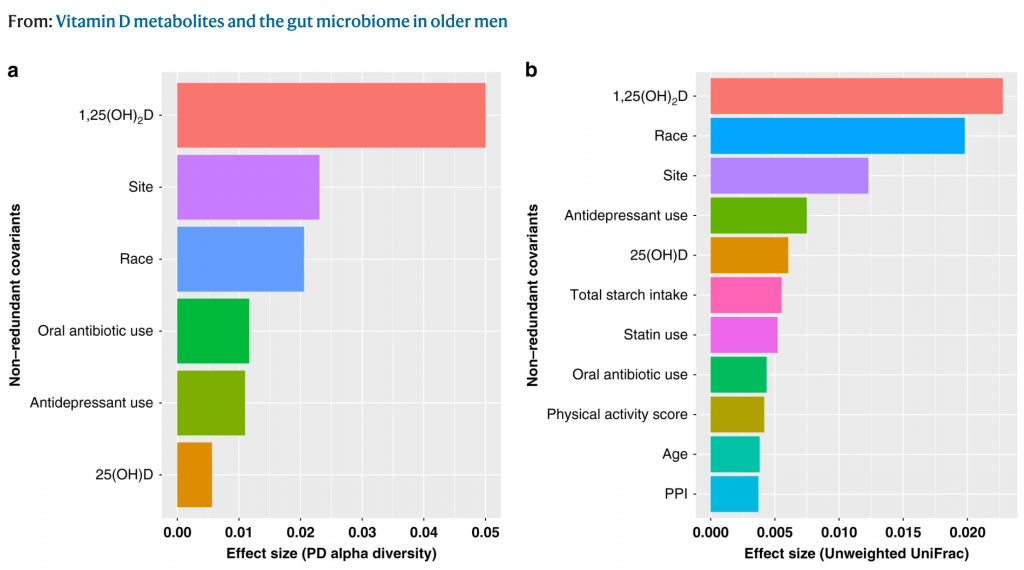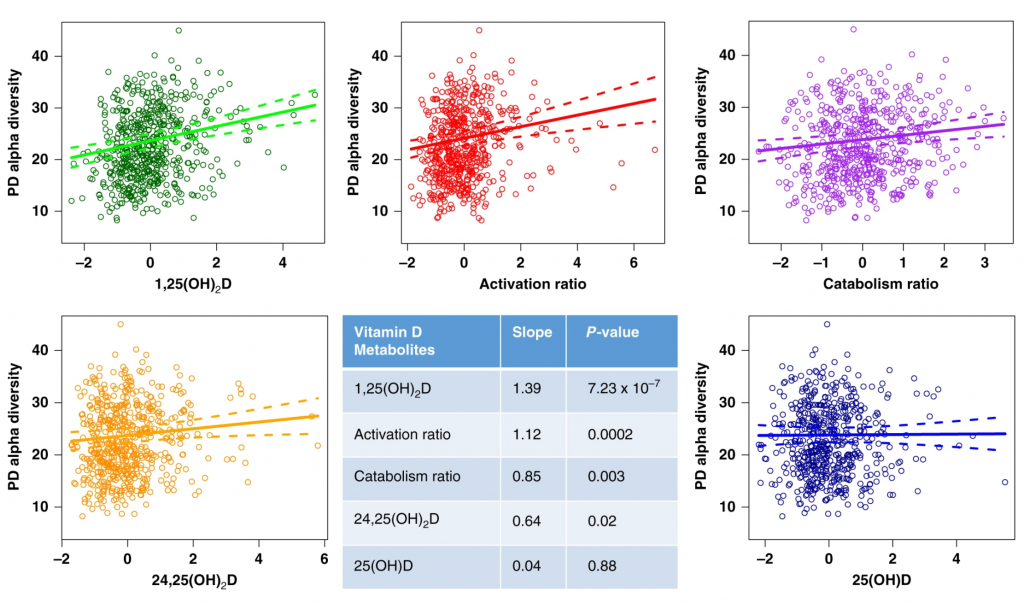University of California San Diego researchers and collaborators recently demonstrated in older men that the makeup of a person’s gut microbiome is linked to their levels of active vitamin D. The study results show that active vitamin D levels are connected to gut microbiome, which is important for bone health and immunity.
The study, published in Nature Communications, also revealed a new understanding of vitamin D and how it’s typically measured. Vitamin D can take several different forms, but standard blood tests detect only one, an inactive precursor that can be stored by the body. To use vitamin D, the body must metabolize the precursor into an active form.
“We were surprised to find that microbiome diversity — the variety of bacteria types in a person’s gut — was closely associated with active vitamin D, but not the precursor form,” said senior author Deborah Kado, MD, director of the Osteoporosis Clinic at UC San Diego Health. “Greater gut microbiome diversity is thought to be associated with better health in general.”
Kado led the study for the National Institute on Aging-funded Osteoporotic Fractures in Men (MrOS) Study Research Group, a large, multi-site effort that started in 2000. She teamed up with Rob Knight, PhD, professor and director of the Center for Microbiome Innovation at UC San Diego, and co-first authors Robert L. Thomas, MD, PhD, fellow in the Division of Endocrinology at UC San Diego School of Medicine, and Serene Lingjing Jiang, graduate student in the Biostatistics Program at Herbert Wertheim School of Public Health and Human Longevity Sciences.
Multiple studies have suggested that people with low vitamin D levels are at higher risk for cancer, heart disease, worse COVID-19 infections and other diseases. Yet the largest randomized clinical trial to date, with more than 25,000 adults, concluded that taking vitamin D supplements has no effect on health outcomes, including heart disease, cancer or even bone health.
“Our study suggests that might be because these studies measured only the precursor form of vitamin D, rather than active hormone,” said Kado, who is also professor at UC San Diego School of Medicine and Herbert Wertheim School of Public Health. “Measures of vitamin D formation and breakdown may be better indicators of underlying health issues, and who might best respond to vitamin D supplementation.”
The team analyzed stool and blood samples contributed by 567 men participating in MrOS. The participants live in six cities around the United States, their mean age was 84 and most reported being in good or excellent health. The researchers used a technique called 16s rRNA sequencing to identify and quantify the types of bacteria in each stool sample based on unique genetic identifiers. They used a method known as LC-MSMS to quantify vitamin D metabolites (the precursor, active hormone and the breakdown product) in each participant’s blood serum.
- In addition to discovering a link between active vitamin D and overall microbiome diversity, the researchers also noted that 12 particular types of bacteria appeared more often in the gut microbiomes of men with lots of active vitamin D.
- Most of those 12 bacteria produce butyrate, a beneficial fatty acid that helps maintain gut lining health.
“Gut microbiomes are really complex and vary a lot from person to person,” Jiang said. “When we do find associations, they aren’t usually as distinct as we found here.”
Figure 1


Almost 7% of the men reported having taken antibiotics in the past 30 days of the clinic visit. Few men were vitamin D deficient (7.2%; 25(OH)D < 20 ng/ml) and most reported taking some form of vitamin D supplementation (74.8%). Notably, 1,25(OH)2D and 24,25(OH)2D vitamin D levels were significantly correlated with 25(OH)D levels (Pearson correlation coefficient of 0.43, p < 0.001 and coefficient of 0.80, p < 0.001, respectively). Serum 24,25(OH)2D levels also decreased relative to 1,25(OH)2D levels in vitamin D deficient patients (p < 0.001).
Because they live in different regions of the U.S., the men in the study are exposed to differing amounts of sunlight, a source of vitamin D. As might be expected, participants from the clinical site (San Diego) with most annual sun exposure had the highest 25(OH)D levels compared to those with less sun exposure (Minneapolis, Pittsburgh, Portland, and Birmingham) (Fig. 1b)17. However, there were no differences in 1,25(OH)2D levels across sites, indicating that while sun exposure may affect the storage form of vitamin D, there appears to be less influence on the active hormone.
“It seems like it doesn’t matter how much vitamin D you get through sunlight or supplementation, nor how much your body can store,” Kado said. “It matters how well your body is able to metabolize that into active vitamin D, and maybe that’s what clinical trials need to measure in order to get a more accurate picture of the vitamin’s role in health.”
1: 25(OH)D levels vary with site and sun exposure, but 1,25(OH)2D levels do not follow this association.

“We often find in medicine that more is not necessarily better,” Thomas added. “So in this case, maybe it’s not how much vitamin D you supplement with, but how you encourage your body to use it.”
Kado pointed out that the study relied on a single snapshot in time of the microbes and vitamin D found in participants’ blood and stool, and those factors can fluctuate over time depending on a person’s environment, diet, sleep habits, medications and more. According to the team, more studies are needed to better understand the part bacteria play in vitamin D metabolism, and to determine whether intervening at the microbiome level could be used to augment current treatments to improve bone and possibly other health outcomes.
Conclusion/ Here we show that in 567 community-dwelling older men, higher levels of the biologically active form (1,25(OH)2D) and vitamin D activation and catabolism ratios, but not 25(OH)D, are associated with greater α-diversity. In addition, those men with the highest compared to lowest 1,25(OH)2D and activation ratios are more likely to possess butyrate-producing bacteria that are associated with favorable gut microbial health. These results support the underlying hypothesis that the human gut microbiome and vitamin D metabolism are integrally related.
Click Here for Full Text Study





